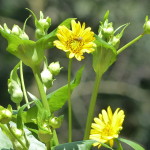by Winding Pathways | Sep 9, 2015 | Birds, Nature
An old legend has it that seeing a bluebird guarantees a day of good luck. At Winding Pathways we’re enjoying daily good fortune because a pair of these delightful birds is raising youngsters in our yard.
In the days of diverse farms with hedgerows separating fields, closely cropped pastures, and wooden fence posts that often had nesting cavities, bluebirds were abundant.
The switch to metal fence posts didn’t help them, and then farms grew larger, hedgerows and posts were ripped out, and pastures and hayfields became oceans of corn and soybeans. None of the changes helped bluebirds just as pesticides eliminated their insect meals.
Fortunately, bluebirds readily move into bird houses, and this spring we erected one in the corner of the only lawn we continue to mow. The box is mounted on a steel post with a predator guard below the house to keep marauding raccoons away from the birds.
We didn’t expect bluebirds to move in. There aren’t many around and they are notoriously fussy about nest sites. Good news came when a pair moved in and raised what’s likely their second brood of the summer.
Bluebirds are fun to watch. Ours perch on the flagpole and a post that holds a big bell at the entrance of our labyrinth. We delight watching them beeline to the lawn and emerge with a tasty bug to feed their youngsters.
Bluebirds nest in suburbia. Anyone with large lawn has fair odds of attracting them. If you erect a box in early spring, remove any “squatting” sparrows, avoid pesticides, and add a predator guard to keep raccoons at bay, you just might attract bluebirds and be assured of good luck.
DID YOU KNOW THAT SOMETIMES BLUEBIRDS CAN BE SPOTTED IN THE DEAD OF WINTER, EVEN IN THE FRIGID NORTH? When cold weather arrives bluebirds shift their diet from insects to frozen and dried fruit. They often moved from grassy to brushy places. Look for them in thickets even in the dead of winter. So be sure to plant fruit bearing shrubs like High Bush Cranberries along with other native species.
For more information about bluebirds or nearly any other species go to Cornell Lab of Ornithology and click on the photo of bluebirds or the species you would like to learn more about.
by Winding Pathways | Aug 22, 2015 | Amphibians/Reptiles, Nature
Many Iowans, even those living in urban areas, may be startled to see a fast moving snake in their yard. No worries. Most likely it is a garter snake. While startling to see, they are a desirable predator in yards and natural places. They are easily identified by it s small head and the three stripes running down its body. The name may be a misspoken form of German or refer to ‘garters’ that people used to use to hold up stockings. At any rate, they are interesting, helpful , and thus, desirable reptiles to have in the yard.
Garter snakes eat snails, worms, insects, small rodents, and nearly any other animal life they discover. However, they are also on the list of prey for other predators from raptors to other snakes. So this petite species normally flees when it detects danger. They also can emit a foul smell when threatened. Females give birth to as many as 70 babies in late summer or fall. These six inch mini snakes can be common in yards. Most do not survive because other predators gobble them up. So if you see one slithering under leaves or a rock to get out of danger, let it be. It helps keep the balance of nature in your yard.
Many species of garter snake inhabit North America. Three species – the common and plains garter snakes and the ribbon snake – live in Iowa. All have slender bodies with lines extending from head to tail. These native reptiles thrive in a diversity of habitats but usually prefer living in moist places near streams or in well-watered gardens. They are excellent swimmers and move quickly and gracefully over the ground.
The common garter snake ‘s range is wide spread and more cold tolerant than most reptiles and even inhabits southern Alaska. In Iowa they are sometimes spotted in late fall after other snakes have entered hibernation.
Of all snakes the garter is the one most likely to be seen in town. Although they startle humans this colorful and shy wild animal is no more harmful or dangerous than goldfinches or cottontails. Winding Pathways encourages folks to respect and thank them for the part they play in keeping the balance of nature.
by Winding Pathways | Aug 10, 2015 | Flowers/Grasses, Nature

Late summer bloomers like cup Plant attract many pollinators.
One of the most interesting wildflowers has a long blooming season from mid-summer until early September and is host to a vast diversity of wildlife.
The Cup Plant (Silphium perfoliatum) gets its name from cups that form along the square stem of this large Silphium. Heavy dew and rain channel down leaves and stems to collect in the small cups of the leaves that gather around the stalks (perfoliatum) where birds and insects sip the moisture. This plant is nature’s watering hole, but it does even more to attract wildlife.
The showy flowers are sunflower-like and their brilliant color reflects the late summer hues of male goldfinches. This bird loves cup plants, where it drinks water, snacks on insects attracted to it and later in the fall eats the seeds. When in bloom cup plants are loaded with pollinators. Bumblebees and yellow and black swallowtail butterflies are frequent guests.
Cup plants live from the Great Plains east to the Atlantic and usually can be found in moist soil on the edge of woods. They thrive in yards but beware! This plant can grow to be ten feet tall. They are easily propagated from roots and tend to spread.
We have a big clump of cup plants near our back deck at Winding Pathways and enjoy watching a never ending stream of insects and birds visit the blooms. They are tall and block vision, so when the last seed is gleaned by an autumn goldfinch we cut down the stems but look forward to next year’s regrowth.
by Winding Pathways | Jul 17, 2015 | Mammals, Nature, Pests
Chipmunks are one of the most common backyard wild animals. These small striped rodents enjoy living in shady yards that have some form of structure for them to hide in or around. Sometimes people confuse them with thirteen lined ground squirrels, which are about the same size but prefer to live in large lawns in the open sun.
Several species of chipmunks live in the United States. Most are in the West and the most commonly encountered species is the Eastern Chipmunk that frequent yards.
Chipmunks love retaining walls and woodpiles, especially those that have many nooks and crannies. They are efficient diggers and sometimes make so many tunnels that a wall slumps or collapses and a woodpile teeters over.
The small mammals eat seeds, fruit, and an occasional insect. They are efficient tree climbers and harvest fruits like cherries on the uppermost slender branches. Chipmunk heaven is a shady yard with a retention wall and bird feeder to provide a daily seed banquet.
Some people resent chipmunks because of their incessant tunneling. Box trapping and moving the animals rarely reduces the population of a species that has many babies. Keeping bird seed off the ground and contained in feeders may reduce a chipmunk population somewhat. Hawks and snakes enjoy dining on these small mammals. Encouraging predators to share the yard will help keep chipmunk numbers in check.
We like the chipmunks that live in our backyard at Winding Pathways. They’re beautiful animals that make us smile when we spot one with cheek pouches crammed with seeds. They’ve undermined our low rock wall in a few places, but we just repair it and consider the damage a small price to pay for the wonderful entertainment chipmunks provide on summer days.
by Winding Pathways | Jul 6, 2015 | Nature, Trees/Shrubs
Each summer a small tree in our yard produces more delicious cherries than we can harvest and eat.
Tart cherries are outstanding yard trees. They are small, attractive, need little care and begin bearing fruit when only a couple of years old. Trees self-fertile, meaning it’s not necessary to plant two or more for cross pollination. Few insects or diseases bother them but sometimes birds, especially robins, take a fancy to the bright red fruit. Birds prefer mulberries to cherries so we keep a mulberry in the yard as our decoy tree to keep birds from filching cherries.
Commercial nurseries sell two general types of domestic cherry trees-sweet and sour (sometimes called tart or pie cherries). Sweet cherries don’t like subzero winters and are best grown in places warmer than our Iowa yard. The fruit is commonly sold in grocery stores and is delicious fresh. Most varieties need a second tree for cross pollination. In contrast tart cherries don’t seem to mind occasional 25 below zero temperatures and thrive in the north. Rarely sold fresh in stores, tart cherries can usually only be purchased canned. To enjoy delicious fresh tart cherries grow your own.
Two common tart cherry varieties we like are Montmorency and Dwarf North Star. Both produce tasty fruit. Sometimes the fruits are sweet enough to eat right off the tree. But usually their tartness makes them best when used in pies, cobblers, and other baked goods. We like them in our morning oatmeal.
The downside of cherries is the time it takes to pick and pit the small fruits. It can be tedious. Dwarf trees reduce or eliminate the need for ladders, making picking safe, fast and easy. We used to hand pit the fruits using fingers to squeeze the large seed out of each cherry. After a few years of this slow process we bought a cherry pitting device that speeds and eases the process, but it still takes time.
Pitted cherries freeze well. Put a big handful in a plastic freezer bag, squeeze out the air, seal the bag and put it in the freezer to retrieve months later when the urge for cherry pie arises.
by Winding Pathways | Jun 21, 2015 | Chickens, Garden/Yard, Nature, Trees/Shrubs
As we welcome summer we also begin to indulge in Iowa’s natural harvest of berries and cherries. Mulberries must be ripe because purple colored bird droppings mark lawns and sidewalks. Scat from raccoons and coyotes are full of seeds. Mulberries are great to eat out of hand and we get great laughs from the purple tongues and fingers that result from our munching them.
Black Raspberries, or “Black caps”, are ripening. Red raspberries big as your thumb fall into your hands and cherries hang tantalizingly just beyond reach on the most slender branches. If the weather stays warm but moist, we will have excellent blackberries come mid-July into August.
Squirrels and birds naturally have an advantage over humans and our chickens make sure that they clean up any cherries that escape the squirrels. But we are out with the best of them harvesting the fruits of an Iowa summer, indulging in fresh berries by the handful and freezing some for winter.
Take time to walk a trail and have fun with summer’s bounty.

